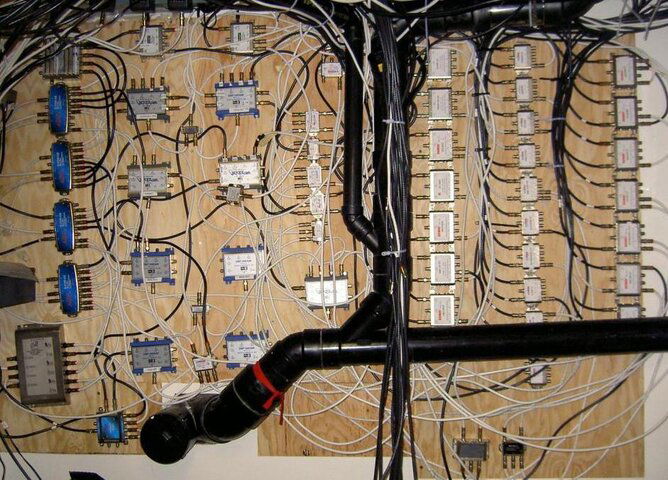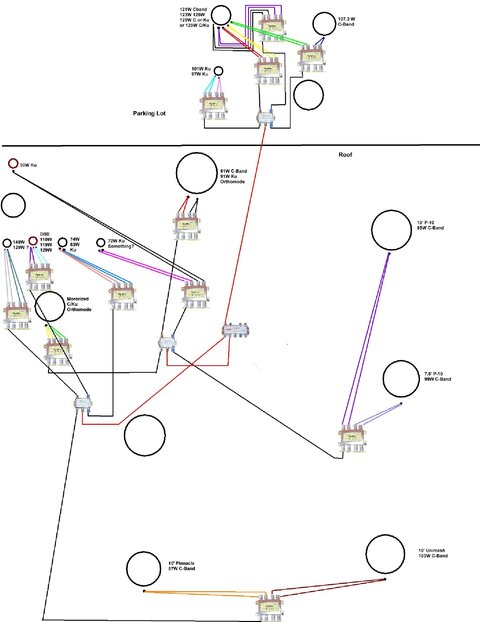My 44x8 switch matrix is operational, but it's still being tweaked and with all the projects I'm juggling, I will only have time to document it once. Sorry. At the moment I'm feeding it with 18 orthomode LNB outputs and about 26 bandstacked LNBs, and all the receiver outputs are spoken for. My remaining struggles are whether to expand it to 56x8, and/or special case some paths so I can employ more receivers.
Switches - I've tested all sorts of these things to varying degrees. I'm not fond of the unpowered 4x4s at all. They have significant frequency-dependent losses, are very prone to saturation and are not a good fit for bandstacked LNBs. The WNC 4x8 is a great powered switch that will pass up to 2150 MHz, but only in a pinch and with a lot of roll-off at the top end. The WNCs have some healthy gain built-in (average of 7 dB) and in my experience are almost immune to saturation. They are a great choice if your only need to pass 950-1450 MHz. The unpowered Zinwell 6x8 is much better at high frequencies than the WNC and works very well with bandstacked LNBs. I have a minor concern about its susceptibility to overload, but I haven't yet had a chance to test this. In terms of DiSEqC switches, I've tested the Pansat and Chieta 4x1s and the Digiwave 8x1s. The Chieta were not flat across the entire L-band and I only use them for accessory switching. The Pansats and Digiwaves work fine for my purposes.
Losses and CNR - FTA LNBs have output levels far above the theoretical noise floor for an ideal 75 ohm resistor. As long as the components in the signal chain don't introduce too much tilt, add an incredible amount of noise or are easily prone to saturation, dealing with any attenuation should be trivial - just add amplification at the correct place(s). However people here are petrified with the thought of any loss and are unwilling to employ amps for any reason.
I'll try to say it another way. A 3 dB loss in level is NOT a 3 dB loss in CNR unless you are doing something horribly wrong. For almost all intents and purposes in FTA a 3 dB loss after the LNB output should mean a 0 dB loss in CNR. However if you fail to use the appropriate tools, a 3 dB loss may cause an even larger loss than 3 dB in CNR.
If I take a full 36 MHz transponder and consider the theoretical limit of noise in a 75 ohm terminator at room temperature, I calculate a noise floor of -92 dBm. If the signal is less than 36 MHz in bandwidth, the noise will be lower. However I'm choosing the worst case. I try to keep most of my signals peaking at around -30 to -40 dBm at the receiver input. Even if I'm lucky enough to get a 25 dB CNR, the background noise output by the LNB at the receiver input is no lower than -65 dBm, or 27 dB above the thermal noise limit. An amplifier with a NF of 5 dB is going to introduce a completely negligible and unmeasurable amount of noise. However if you let too many losses impinge on your signal without an amp, the LNB's background noise output can quickly fall below the theoretical limit and even more easily the receiver's noise floor. Then you are losing CNR big time. Please stop worrying about simple losses and use an amplifier when they accumulate.
Manual coax switches - I had some cheap ones lying around from OTA use and bought a few others for testing purposes. They aren't very good and show a lot of variation from sample to sample. Measured losses and VWSR can change a lot for each switch cycle. You might get away with 950-1450 MHz some of the time, but these are horrible alternatives to electrical switches. There are commercial mechanical coax switches that have incredible specs, but the prices are very high. Unless you have access to good surplus sources, I would not bother with manual coax switches.
 Please share your thoughts and arguments about the best switch models you currently use in your system, or would be happy to buy if only..., or plan to get for your incoming system upgrade, and WHY did you pick this particular switch or switch combo? Of course, your very own switchbox photos would be highly appreciated. :up
Please share your thoughts and arguments about the best switch models you currently use in your system, or would be happy to buy if only..., or plan to get for your incoming system upgrade, and WHY did you pick this particular switch or switch combo? Of course, your very own switchbox photos would be highly appreciated. :up




